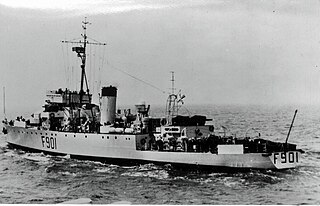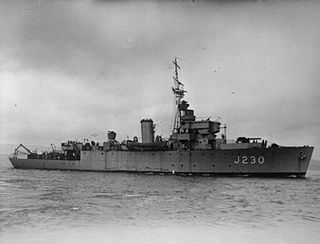
The Algerine-class minesweeper was a large group of minesweepers built for the Royal Navy (RN) and the Royal Canadian Navy (RCN) during the Second World War. 110 ships of the class were launched between 1942 and 1944.

HMS Hydra was a reciprocating engine-powered Algerine-class minesweeper built for the Royal Navy during the Second World War. She was badly damaged during the war and was scrapped in 1947.
HMCS Kapuskasing was an Algerine-class minesweeper that served in the Royal Canadian Navy during the Second World War. The vessel was primarily used as a convoy escort in the Battle of the Atlantic. Following the war she saw service as a hydrographic survey ship with the Department of Mines. She was named for Kapuskasing, Ontario.
HMCS Oshawa was a reciprocating engine-powered Algerine-class minesweeper built for the Royal Canadian Navy during the Second World War. Following the war, the ship was converted to an oceanographic research vessel and remained in this capacity until being scrapped in 1966.
HMS Postillion was a reciprocating engine-powered Algerine-class minesweeper during the Second World War. She was ordered for the United States Navy as USS AM 335, but was transferred on completion under Lend-Lease to the Royal Navy as Postillion. She survived the war and was returned to the USN, being sold to the Greek Navy in 1947.
HMCS Rockcliffe was a reciprocating engine-powered Algerine-class minesweeper built for the Royal Canadian Navy during the Second World War. Following the war, the ship saw service as training vessel before being scrapped in 1960.
HMCS Middlesex was a reciprocating engine-powered Algerine-class minesweeper built for the Royal Canadian Navy during the Second World War. Entering service in 1944, the vessel served as a convoy escort in the Battle of the Atlantic. Following the war, the ship ran aground on 2 December 1946 and broken up for scrap.

HMCS Fort Frances was an Algerine-class minesweeper that served in the Royal Canadian Navy during the Second World War. She served primarily as a coastal convoy escort in the Battle of the Atlantic. The ship was named for Fort Frances, a town in northwestern Ontario. Following the war, the vessel was transferred to the Department of Mines and Technical Surveys and used for hydrographic and oceanographic survey. The vessel was discarded in 1974 and broken up for scrap.
HMCS New Liskeard was a reciprocating engine-powered Algerine-class minesweeper built for the Royal Canadian Navy during the Second World War. Following the war, the ship saw service first as a training ship and then later, as an oceanographic research vessel. She remained in service until 1969.
HMCS Portage was a reciprocating engine-powered Algerine-class minesweeper built for the Royal Canadian Navy during the Second World War. Following the war, the ship saw service as a training vessel before being scrapped in 1961.
HMCS St. Boniface was a reciprocating engine-powered Algerine-class minesweeper built for the Royal Canadian Navy during the Second World War. During the war, the vessel was used as a convoy escort in the Battle of the Atlantic. Following the war, the ship was sold for civilian use as a merchant vessel, last being registered in 1954.

HMCS Wallaceburg was an Algerine-class minesweeper that served in the Royal Canadian Navy during the Second World War as a convoy escort during the Battle of the Atlantic. After the war the vessel was used from 1950 to 1959 for cadet training. In 1959 she was sold to the Belgian Navy and served until 1969 as Georges Lecointe, the second ship to be named after Georges Lecointe.

HMCS Winnipeg was an Algerine-class minesweeper that served in the Royal Canadian Navy during the Second World War. Used primarily as a convoy escort, the vessel served in the Battle of the Atlantic. Following the war she placed in reserve before being sold to Belgium and renamed A.F. Dufour. She served with the Belgian Navy until 1966.
HMCS Minas was a Bangor-class minesweeper that served in the Royal Canadian Navy during the Second World War. She saw action in the Battle of the Atlantic and the Invasion of Normandy. She was named for Minas Basin. After the war she was reactivated for a short period of time in 1955 before being sold for scrap.
HMCS Brockville was a Bangor-class minesweeper that served with the Royal Canadian Navy during the Second World War. She was used as a convoy escort in the Battle of the Atlantic and the Battle of the St. Lawrence. Following the war, the vessel was transferred to the Royal Canadian Mounted Police and renamed Macleod. After five years service with them, the ship was reacquired the Royal Canadian Navy and recommissioned. She remained in service until 1958.
HMCS Quinte was a Bangor-class minesweeper constructed for the Royal Canadian Navy during the Second World War. The ship entered service in 1941 and took part in the Battle of the Atlantic. On 30 November 1942, Quinte ran aground and sank off Cape Breton Island. The ship was re-floated and repaired and spent the rest of the war as a training ship. Following the war, the minesweeper was used for naval research until decommissioned in 1946. The vessel was sold for scrap and broken up in 1947.
HMS Minstrel (J445) was a reciprocating engine-powered Algerine-class minesweeper during the Second World War. She survived the war and was sold to Thailand in 1947 as HTMSPhosamton(MSF-1).

HMS Cadmus (J230) was a turbine engine-powered Algerine-class minesweeper during the Second World War. Launched in 1942 the ship survived the war and was sold to Belgium in 1950 as Georges Lecointe (M901).

HMS Felicity (J369) was a reciprocating engine-powered Algerine-class minesweeper during the Second World War.

HMS Lennox (J276) was a reciprocating engine-powered Algerine-class minesweeper during the Second World War.







